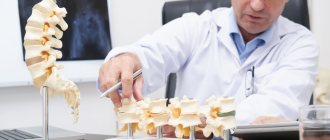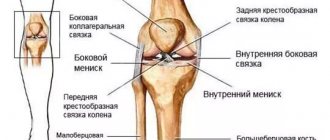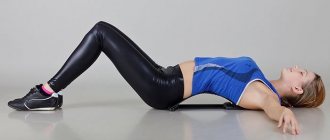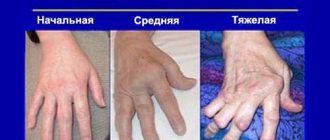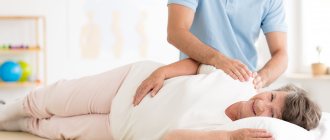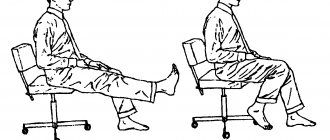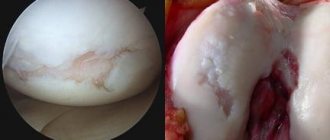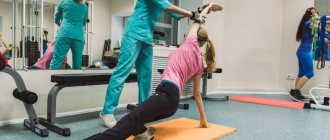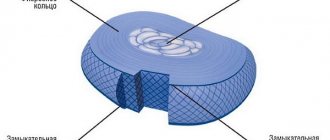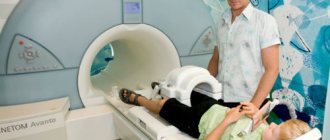Author of the article: Alexandra Burguta, obstetrician-gynecologist, higher medical education in the specialty “General Medicine”.
Article publication date: 03/18/2014
Article updated date: 07/14/2020
Rheumatoid arthritis is characterized by joint deformation, limited mobility and the development of contractures (immobility). To reduce symptoms, treatment includes exercise therapy, massage, swimming and physiotherapy. Therapeutic exercise for rheumatoid arthritis is aimed at strengthening ligaments and muscles, increasing range of motion in joints and slowing down pathological reactions.
Indications and contraindications for physical education
Exercise therapy is indicated for almost all patients. With significant restrictions, it is possible to perform breathing exercises or positional treatment (more details later in the article).
The main contraindications for prescribing physical education:
- exacerbation of rheumatoid arthritis, accompanied by severe pain and inflammation;
- systemic manifestations of the disease with serious damage to internal organs (vessels, kidneys, heart, lungs);
- some concomitant chronic pathologies (infections, cardiovascular and respiratory failure).
Rest is an important part of training
Fatigue is a common symptom of rheumatoid arthritis. Be sure to alternate between training and rest. During short breaks, the joints calm down, pain and fatigue go away. However, rest does not necessarily mean bed rest (unless your doctor recommends it), since inactivity weakens muscles, thereby increasing joint pain.
Expert: Galina Filippova, general practitioner, candidate of medical sciences Author: Olga Gorodetskaya
The material uses photographs belonging to shutterstock.com
Basic methods and stages of classes
All approaches to physical therapy for rheumatoid arthritis can be divided into three groups:
- Individual classes are ideal for patients with the most severe stage of the disease, as well as for rehabilitation after surgical treatment.
- Group classes are the most accessible and rational approach. Patients are grouped according to the degree of mobility limitation.
- During consultations, patients are taught techniques and exercises that they can use at home.
The main condition for exercise therapy in the treatment of rheumatoid arthritis is regularity of exercise and systematic increase in load. Exercises should not be performed with force: after proper physical activity, the patient should experience an increase in strength and a decrease in stiffness.
During inpatient treatment, three periods of rehabilitation can be distinguished:
- Preparatory, when the doctor teaches the patient relaxation and breathing techniques. The duration of these exercises is about 10 minutes, the duration of training is 1–2 days.
- During the main period, a basic set of exercises is performed. Classes take place daily for two weeks, each lasting about half an hour.
- The final stage is carried out before discharge: the doctor teaches the patient exercises that he can do at home.
Tasks and goals of exercise therapy for arthritis and features of implementation
Exercise therapy for arthritis is prescribed by the attending physician for the following purposes:
influence diseased joints to maintain mobility and prevent further impairment of their functionality;- strengthen muscles, increase the patient’s physical endurance and relieve him of the feeling of helplessness, improve the general condition of the patient;
- normalize metabolism, eliminating the feeling of joint stiffness by reducing the amount of deposited salts and relieving acute inflammation;
- reduce pain by adapting the musculoskeletal system to moderate physical activity;
- restore physical performance, conduct high-quality rehabilitation;
- prevent muscle atrophy by improving blood circulation.
IMPORTANT! When prescribing physical therapy, the attending physician must convey to the patient the specifics of its implementation.
- The classes should be based on dynamic movements. Most patients find relief from flexibility exercises.
- You cannot allow pain to develop during exercise. It is necessary to maintain the range of motion, that is, maintain the intensity of the exercises.
- Training should be accompanied by static movements.
- Classes are given at least 1 hour a day.
- At the same time, you should not exercise to the point of complete exhaustion. The patient must soberly assess his physical condition before training, and if it contradicts a full-fledged workout, his time can be reduced or divided into several approaches with breaks of 20-30 minutes.
Treatment by position
The “position” method of treating rheumatoid arthritis is also classified as exercise therapy and is used for severe lesions, when the patient is practically unable to move and is mainly in bed. It should also be carried out during periods of exacerbation of the disease.
What is its essence? The mattress on which the patient lies must be smooth and hard; it is advisable to use a special orthopedic one. The feet should have support; for this you can use either a moving headboard or a stand. You need to change your body position at least once an hour, if necessary with the help of another person.
If contractures begin to form, special splints (hard strips of plaster-impregnated bandages) are applied. If this is difficult to do, you can use rollers, weights and other devices. For example, if the hip joint is affected, a two-level mattress is made, allowing the leg to be extended in a relaxed position.
Gymnastics - a means to prevent arthritis
For arthritis of the finger joints, special exercises should be performed repeatedly. This does not require special conditions, you can perform them even outside the home, the required number of repetitions is up to 9 times daily, which is quite doable for any person. Thanks to active gymnastic exercises, blood circulation improves and inflammatory activity decreases. The fluid accumulated in the periarticular tissues and cavities begins to dissolve, swelling and redness subsides. Gymnastics for arthritis of the hands helps to increase muscle tone . Motor ability in the joints improves, and hand motor skills are gradually restored. If all recommendations are followed, the patient’s general condition improves significantly. Basic rules of health-improving exercises for arthritis:
- systematic and regular implementation of classes;
- perform exercises during an exacerbation of the disease;
- train both hands at the same time;
- monitor free breathing and pace.
Special gymnastics for arthritis consists of simple movements that must be performed in such a way as not to experience discomfort. Many people often develop the disease on one finger of one hand. This may be the beginning of the development of disease in all joints of the hand. In any case, exercises should be performed on both hands. Before starting the exercises, you should consult with your doctor, he will recommend the set of exercises that you need. As a rule, gymnastics for the hands is easy to perform; each exercise should be done an average of 8 times, it all depends on the severity of the disease and general well-being. At first it will be a little difficult to perform individual movements, but gradually the joints will become stronger, the time of exercises and their quality will increase.
Hand exercises
In rheumatoid arthritis, the joints of the fingers are most often affected. Usually the hand takes on the characteristic appearance of a flipper, which leads to limited functionality and disability.
To reduce the strain rate it is advisable to:
- do not move your fingers towards the little finger;
- reduce the load on the fingertips;
- when at rest, ensure the correct position of the hand;
- write only with cone-shaped thickened pens;
- perform everyday activities correctly: trying to ensure that the axis of movement in the joints does not deviate to the side;
- at night, use orthoses - devices that limit mobility.
Here is one set of exercise therapy exercises for hand injuries:
- Starting position: hands in front of you, next to each other. Alternately turn your palms up and down.
- Place your hands on the table and raise and lower them first, and then only your fingers.
- Stretch your hands clenched into fists forward. Rotate the brushes clockwise and counterclockwise.
- Place your elbows on the table, clasp your palms, spread and bring your elbows together without lifting them from the surface.
- Make up-down, left-right and circular movements with each finger in turn.
- Touch each finger to the thumb, as if grasping something round.
- Squeeze and unclench the soft ball in your hand, roll it over the surface.
- Rotate your hands at the wrist joint, while trying to relax your palm.
- Move your fingers along the stick from bottom to top.
- Rub your palms together.
Each exercise should be performed 5–7 times, depending on the patient’s condition. There should be no pain during exercise.
Click on the picture to enlarge
Recommendations for gymnastics
The effectiveness of hand and finger exercises for rheumatoid arthritis can be determined by the reduction in stiffness of movement.
To achieve maximum effect, you should perform the exercises systematically, adhering to the advice and recommendations of rheumatologists and methodologists.
General recommendations for exercise therapy:
- You need to start gymnastics with a warm-up. Before starting exercise, it is better to drink an analgesic, this will relax your joints and make training easier.
- If you feel stiffness in your movements, pre-warm your joints with a heating pad or hand bath.
- Movements should be performed smoothly, without sudden movements or effort. Do each 5-7 times.
- The number of exercises performed depends on your capabilities. The duration of classes is about 20 minutes per day.
- The optimal time for gymnastics is the middle of the day; training at night is not recommended.
- It is recommended to repeat physical exercises up to 8 times a day - you do not need to create specific conditions to do exercises.
- You can train your joints anywhere and anytime. It is important to regularly perform therapeutic exercises for your fingers.
- Physical therapy should not cause discomfort. If painful sensations appear, you should not continue to perform these movements until consulting a doctor.
- It is advisable to do a short warm-up in the morning, but the rest of the time the patient decides when to exercise.
Exercises for lesions of the shoulder girdle
- Raise and lower your shoulders, make circular movements forward and backward.
- Place your palms on your shoulders, alternately bringing your elbows forward.
- Clasping your elbows with your palms, raise them and lower them.
- Lying on your back, bend, raise and lower your straightened arms.
- Place your hands on your belt and alternately place them behind your head.
- Hug yourself.
During exercises, it is very important to maintain the correct breathing rhythm.
The above exercises are called dynamic, that is, related to the movement of the body in space. They are mainly aimed at restoring mobility and preventing contractures.
There is another type of load in which muscle work is not accompanied by movement of the limb, since it is fixed: isometric. Isometric exercise helps strengthen muscle fibers, even with severe mobility limitations. An example of such an exercise: lying on your back, press with straightened arms on the surface.
Daily morning exercises for rheumatoid arthritis
Every morning after waking up, before getting out of bed, you must do exercises. Having done these two exercises, you can slowly and smoothly get out of bed.
- Morning workout for healthy feet
We stretch our entire body, transfer all the tension to our feet, and pull our toes forward. In this position, you need to freeze for 15 seconds, then pull your toes towards you.
- Morning workout for healthy hands
We inhale air, raise our arms above our heads, arch our back and, as we exhale, return to the starting position.
Leg exercises
- Lying on your back, bend your leg at the knee joint without lifting the soles from the surface (sliding steps).
- Exercise bike.
- Move your legs bent at the knees to the sides and bring them back.
- Swing with a straight leg while lying and standing, holding onto a support.
- Circular movements in the hip joint with the leg bent at the knee.
- Raising straight legs to the sides in a lying position.
- Circular movements with a straight leg.
Isometric exercises are performed with the help of an assistant, who provides resistance and prevents the limb from moving.
Ankle exercises
With rheumatoid arthritis, the ankle joint is not often affected, but its deformation quite quickly leads to limited movement and disability. To prevent contracture, it is recommended to perform the following complex:
- While sitting, bend and straighten your feet and toes.
- Roll from heel to toe and back.
- Stand on your toes against a support.
- Try to lift various objects from the floor with your toes.
- Roll a stick or ball with your feet.
- Walk across the stick, stepping on it with the middle part of the sole.
- Make circular movements with your feet.
When performing any complex of therapeutic exercises, it is advisable to alternate isometric and dynamic exercises, breathe correctly, and at the end of the session, conduct a muscle relaxation session.
To increase the load, you can gradually increase the range of motion in the affected joints and the number of repetitions.
There are 3 main factors as the cause of the disease (rheumatological triad)
- Genetic predisposition
- Hereditary tendency to autoimmune reactions
- More common in carriers of a certain MHC II class antigen: HLA - DR1, DR4
- Infectious factor
- paramyxoviruses - mumps, measles, respiratory syncytial infection viruses
- hepatoviruses - hepatitis B virus
- herpes viruses - herpes simplex viruses, herpes zoster, Cytomegalovirus, Epstein-Barr virus
- retroviruses - T-lymphotropic virus
- Triggering factor (hypothermia, hyperinsolation, intoxication, mutagenic medications, endocrinopathies, stress, etc.). For women, breastfeeding for a longer period of time reduces the likelihood of developing RA. Breastfeeding for 24 months or longer reduces the risk of developing RA by half.
Exercises in water
Of all the sports, swimming is most suitable for the treatment of rheumatoid arthritis, since in water there is no stress on the joints due to the weight of the body. With a weight of 60 kg, completely immersed in water, a person feels only 7 kg. Therefore, exercises in the pool can be performed even by patients who practically do not move.
The intensity of the load is determined by the degree of immersion, which allows you to gradually restore motor activity. Higher water density requires greater effort to overcome resistance.
The temperature in the pool also has a positive effect: with thermal exposure, the pain syndrome is significantly reduced.
Contraindications to water activities:
- open damage to the skin;
- allergy to chlorine;
- eye diseases (conjunctivitis);
- lesions of the ear, nose and throat;
- venereal diseases;
- some chronic pathologies of other organs and systems.
In the pool you can perform the following complex:
- Walking with straight and bent legs. It is advisable to spread your arms to the sides so as not to lose balance; if necessary, you can hold on to the support. The water level is adjusted depending on the required load.
- Swing your legs back and forth, to the side, in circular movements.
- Squats with legs wide apart (it is important to keep your back straight).
- Having immersed yourself in water up to your neck, spread your straight arms to the sides and perform circular movements in the shoulder, elbow and wrist joints.
The swimming itself can be free or facilitated (using fins, special foam boards or inflatable objects). Depending on the goals pursued, you can increase the load on your legs or arms.
The benefits of working out in our gym
When doing exercise therapy, a person should feel comfortable and safe. The Kuntsevo Medical and Rehabilitation Center has a large hall with enough modern equipment to avoid downtime for those involved. All classes are held in the presence of professional rehabilitation doctors who will promptly refer the patient and provide medical support.
The result can be tracked without leaving the center by undergoing examinations using MRI and ultrasound machines. And you can maintain and enhance the effect of exercise therapy through courses of manual therapy, massage and acupuncture.
Our specialists have developed special rehabilitation treatment programs that have demonstrated high results. We give you the opportunity to support your results through subscriptions. The patient returns to a familiar environment, to trusted specialists, while saving money and time.
Rehabilitation for arthrosis helps our patients recover and return to their normal lifestyle. It is necessary to understand that this process takes a lot of time, since it is important to consolidate the effect obtained at each stage, without jerks. The patient’s task is to strictly follow the specialist’s recommendations and inform him of any deterioration in health. This will allow you to timely adjust the rehabilitation program and achieve a positive result.
Functional motor test
Before the start of the rehabilitation period, the physical therapy doctor assesses the degree of damage to the patient’s motor system. To do this, you can use various tests, but the most popular is the functional motor study, which lasts only 5–6 minutes. The doctor asks the patient to perform various actions, for each of which a certain number of points is assigned. The test results allow you to objectively assess the dysfunction:
- No functional limitations.
- Maintaining professional ability to work.
- The ability to work is completely lost.
- Cannot take care of himself.
Based on the results obtained, patients are divided into groups and the optimal complex of exercise therapy is selected.
If you have rheumatoid arthritis, don’t give up on yourself. Start doing special exercises. Daily physical therapy exercises will tone your muscles, improve your well-being and increase your mobility. Before starting gymnastics, you should consult your doctor.

